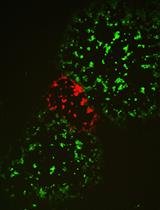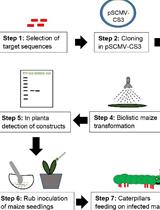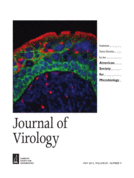- Submit a Protocol
- Receive Our Alerts
- Log in
- /
- Sign up
- My Bio Page
- Edit My Profile
- Change Password
- Log Out
- EN
- EN - English
- CN - 中文
- Protocols
- Articles and Issues
- For Authors
- About
- Become a Reviewer
- EN - English
- CN - 中文
- Home
- Protocols
- Articles and Issues
- For Authors
- About
- Become a Reviewer
Construction of FWPV Chimaeric MVA
Published: Vol 5, Iss 1, Jan 5, 2015 DOI: 10.21769/BioProtoc.1376 Views: 9499
Reviewed by: Anonymous reviewer(s)

Protocol Collections
Comprehensive collections of detailed, peer-reviewed protocols focusing on specific topics
Related protocols

Quantification of HIV-2 DNA in Whole Blood
Zsófia Szojka [...] Patrik Medstrand
Oct 20, 2019 5998 Views

Selection of Vaccinia Virus Recombinants Using CRISPR/Cas9
Anjali Gowripalan [...] David C. Tscharke
Dec 20, 2021 3404 Views

Inoculation of Maize with Sugarcane Mosaic Virus Constructs and Application for RNA Interference in Fall Armyworms
Iram Gull and Georg Jander
Jul 20, 2023 2172 Views
Abstract
Construction of chimaeric MVA is a useful tool with which to study gene function of related viruses. The protocol given here describes MVA chimaeras containing genes from Fowlpox virus (FWPV), although this can be applied to DNA derived from other organisms. There are a number of steps required to make the chimaeric MVA: 1) Purification of viral particles; 2) Extraction of DNA from purified viral particles; 3) Assembly of linear recombination templates; 4) Transfection of linear recombination templates; 5) Selection of chimaeric MVA.
Note: This procedure uses live virus, and should be conducted using Good Microbiological Practice, in accordance with international and national biocontainment requirements. This procedure also involves Genetic Modification of microorganisms, and appropriate safety approval should be obtained before commencing.
Materials and Reagents
- Purification of viral particles
- Fowlpox virus (FWPV) (e.g. ATCC, catalog number: VR-251 )
- Modified Vaccinia virus Ankara (MVA) (ATCC, catalog number: VR-1508 )
- CEF cells (Institute for Animal Health)
- Tris-EDTA buffer (Sigma-Aldrich, catalog number: 93283 )
- DMEM (e.g. Sigma-Aldrich, catalog number: D6429 )
- Foetal bovine serum (FBS) (e.g. Sigma-Aldrich, catalog number: F9665 )
- 10x medium 199 with Earle’s salts (Sigma-Aldrich, catalog number: M0650 )
- Heat Inactivated newborn bovine serum (Life Technologies, catalog number: 26010074 )
- Tryptose phosphate broth (Sigma-Aldrich, catalog number: T8159 )
- Nystatin (Sigma-Aldrich, catalog number: N1638 )
- Penicillin-streptomycin solution (Sigma-Aldrich, catalog number: P4333 )
- L-glutamine solution (Sigma-Aldrich, catalog number: G7513 )
- Sodium bicarbonate (Sigma-Aldrich, catalog number: S8761 )
- Amicon Ultra-15 Centrifugal filter unit (100 kDa membrane NMWL) (Merck Millipore, catalog number: UFC910024 )
- FWPV virus growth medium (see Recipes)
- MVA virus growth medium (see Recipes)
- TE (see Recipes)
- Fowlpox virus (FWPV) (e.g. ATCC, catalog number: VR-251 )
- Extraction of DNA from purified viral particles
- Phenol saturated with 10 mM Tris-HCl (Sigma-Aldrich, catalog number: P4557 )
- Phenol-chloroform-isoamyl alcohol (25:24:1, saturated with 10 mM Tris, pH 8.0) (Sigma-Aldrich, catalog number: P2069 )
- Chloroform-isoamyl alcohol (24:1) (Sigma-Aldrich, catalog number: 25666 )
- 3 M Sodium acetate (Sigma-Aldrich, catalog number: 71196 )
- Ethanol (Sigma-Aldrich, catalog number: E7023 )
- 10 mM Tris-Cl (pH 8.5) (QIAGEN, catalog number: 19086 )
- Tris-HCl (Sigma-Aldrich, catalog number: T5941 )
- EDTA (Sigma-Aldrich, catalog number: EDS )
- NaCl (Sigma-Aldrich, catalog number: S3014 )
- SDS solution (Sigma-Aldrich, catalog number: 71736 )
- β-mercaptoethanol (Sigma-Aldrich, catalog number: M3148 )
- Proteinase K (Sigma-Aldrich, catalog number: P2308 )
- 2x extraction buffer (see Recipes)
- Phenol saturated with 10 mM Tris-HCl (Sigma-Aldrich, catalog number: P4557 )
- Assembly of linear recombination templates
- PCR oligonucleotides (Sigma-Aldrich)
- Accuprime Taq high fidelity polymerase (Life Technologies, catalog number: 12346086 )
- pNEB193 (New England Biolabs)
- Plasmid encoding Escherichia coli (E.coli) gpt under p7.5 promoter (e.g. pGNR, available on request)
- QIAquick PCR purification kit (QIAGEN, catalog number: 28104 )
- QIAquick gel extraction kit (QIAGEN, catalog number: 28704 )
- PCR oligonucleotides (Sigma-Aldrich)
- Transfection of linear recombination templates
- DF-1 cells (ATCC, catalog number: CRL-12203 )
- DMEM (e.g. Sigma-Aldrich, catalog number: D6429)
- Foetal bovine serum (FBS) (e.g. Sigma-Aldrich, catalog number: F9665)
- Penicillin-streptomycin solution (Sigma-Aldrich, catalog number: P4333)
- Salmon sperm DNA solution (Life Technologies, catalog number: 15632011 )
- Opti-MEM (Life Technologies, catalog number: 31985062 )
- Polyfect (QIAGEN, catalog number: 301105 )
- DF-1 culture medium (see Recipes)
- DF-1 cells (ATCC, catalog number: CRL-12203 )
- Selection of chimaeric MVA
- DMEM (e.g. Sigma-Aldrich, catalog number: D6429)
- Foetal bovine serum (FBS) (e.g. Sigma-Aldrich, catalog number: F9665)
- Penicillin-streptomycin solution (Sigma-Aldrich, catalog number: P4333)
- Mycophenolic acid (Sigma-Aldrich, catalog number: M5255 )
- Xanthine (Sigma-Aldrich, catalog number: X3627 )
- Hypoxanthine (Sigma-Aldrich, catalog number: H9636 )
- Hydrochloric acid (Sigma-Aldrich, catalog number: H9892 )
- Sodium hydroxide (Sigma-Aldrich, catalog number: S2770 )
- 2% DMEM + MXH (see Recipes)
- DMEM (e.g. Sigma-Aldrich, catalog number: D6429)
Equipment
- Benchtop centrifuge (e.g. Hettich®, model: Rotanta 460 )
- Thermal cycler (Techne Progene®)
- Laminar flow microbiological safety cabinet (e.g. HeraSafe®, model: 51022738 )
- Humidified CO2 incubator (e.g. Thermo Fisher Scientific, model: BB15 )
- Cuphorn sonicator (e.g. UltrasonicsTM, model: W-375 )
Procedure
- Purification of viral particles
Use aseptic technique, in a laminar flow microbiological safety cabinet.
- Infect confluent CEF cells with FWPV or MVA at 0.01 plaque-forming units (pfu) per cell.
Note: The number of cells to infect will depend on the number of chimaeric MVA viruses to be made. As a guide, 30 infected 175 cm2 flasks of FWPV yields ~150 μg DNA; 2 infected175 cm2 flasks of MVA yields ~800 ng DNA.
- Culture in virus growth medium at 37 °C 5% CO2 for 5-7 days, until extensive cytopathic effects are visible.
- Freeze-thaw the culture (still in the flask) 3 times.
Note: Freeze at -80 °C. The flask may be thawed at room temperature or 37 °C, but do not leave at elevated temperature longer than absolutely necessary.
- Transfer the infected cell lysate to a centrifuge tube.
- Centrifuge at 1,500 x g for 15 min.
- Transfer the supernatant to an Amicon Ultra-15 Centrifugal filter unit (100 kDa NMWL).
- Centrifuge at 1,500 x g for 60 min at 4 °C.
- Resuspend the lysate retained on the membrane (approx. 200 μl) containing virus particles in 2 ml TE.
- Store at 4 °C overnight, or proceed directly to Section B.
- Infect confluent CEF cells with FWPV or MVA at 0.01 plaque-forming units (pfu) per cell.
- Extraction of DNA from purified viral particles
- Combine the purified viral particles with an equal volume of 2x extraction buffer.
- Incubate at 55 °C for 2 h.
- Add an equal volume of phenol saturated with 10 mM Tris-Cl at pH 8.0.
- Agitate at room temperature for 195 min.
- Centrifuge at 1,500 x g for 5 min.
- Transfer the aqueous layer to an equal volume of phenol-chloroform-isoamyl alcohol (25:24:1, saturated with 10 mM Tris, pH 8.0).
- Agitate at room temperature for 1 h.
- Centrifuge at 1,500 x g for 5 min.
- Transfer the aqueous layer to an equal volume of 24:1 chloroform-isoamyl alcohol.
- Agitate at room temperature for 1 h.
- Centrifuge at 1,500 x g for 5 min.
- Transfer the aqueous layer to a clean tube.
- Add 0.1x volume 3 M sodium acetate and 2.5x volume ethanol and mix.
- Centrifuge at 1,500 x g for 15 min.
- Aspirate the supernatant.
- Wash the DNA pellet in 70% ethanol.
- Air-dry the DNA pellet.
- Dissolve the DNA pellet in 200 μl 10 mM Tris-Cl (pH 8.5).
- Store DNA at -80 or -20 °C.
- Combine the purified viral particles with an equal volume of 2x extraction buffer.
- Assembly of linear recombination templates. See Figure 1 for a schematic showing the final assembled recombination template.
Note: For steps C1-3, the following conditions are recommended: initial denaturation at 94 °C, followed by 30 cycles of denaturation at 94 °C for 30 sec, annealing for 30 sec, and extension at 68 °C for 1 min per kilobase. Add a final extension step at 68 °C for 10 min. Reactions should contain 300 nM of each primer. See “Standard PCR Protocol” (He, 2011).
- Using PCR and 0.02 IU/μl of Accuprime Taq High Fidelity polymerase with the supplied polymerase Buffer II, amplify a 489 bp product from 20 ng of purified MVA DNA template with primers KB1F (TGGTCAATCGCCATTTGTTCG) and KB1R (GGACATAGTGCCTTGTATTATG). Set the annealing temperature to 43 °C, and cycling extension to 30 sec. This product will be referred to as FLL.
- Using PCR and a high fidelity polymerase, amplify a 557 bp PCR product from 20 ng of purified MVA DNA template with primers KB4F (GCTATTCGACATCGAGAACAATCTTTGC-TAGAGAGAAAGC) and KB4R (GAGGGATATTAAGTCGATAG). Set the annealing temperature to 40 °C, and cycling extension to 30 sec. This product will be referred to as FLR.
- Using PCR and a high fidelity polymerase, amplify a 853 bp PCR product from a plasmid containing the E. coli GPT gene downstream of the Vaccinia virus p7.5 promoter [(e.g. plasmid pGNR, as described in Boulanger et al. (1998)]. In this publication, a cassette containing the E. coli gpt gene under the control of the vaccinia virus p7.5 early/late promoter was cloned into the SmaI site of pNEB193. Primers are KB3F (GGATGCAGCCTCCAG-AATAC) and KB3R (GCTTTCTCTCTAGCAAAGATTGTTCTCGATGTCGAATAGC). Set the annealing temperature to 46 °C, and cycling extension to 60 sec.
- After confirming that all PCRs contain a single product of the expected size, purify each product using a QIAquick PCR Purification kit and elute into 10 mM Tris-Cl (pH 8.5).
- Use splice-overlap-extension PCR to anneal the GPT and FLR products together: The first 5 cycles are annealed at 57 °C in the absence of primers. Primers KB3F and KB4R are then added prior to an additional 30 cycles with annealing at 43 °C. This 1,390 bp product, referred to as RHS, should be purified by agarose gel electrophoresis, but avoid exposure to ultraviolet light.
- Design primers to amplify the FWPV gene of interest. The forward primer should have a 5’ tail complementary to primer KB1R. The reverse primer should have a 5’ tail complementary to primer KB3F. The FWPV product can be up to 8 kbp long.
- Using PCR and a high fidelity polymerase, amplify the FWPV product designed in step C6 from 100 ng of purified FWPV DNA (from step B). Purify this product by agarose gel electrophoresis and a QIAquick Gel Extraction kit. Elute into 10 mM Tris-Cl (pH 8.5). Products over 2 kbp should not be exposed to ultraviolet light, to avoid photo-nicking.
- Use splice-overlap-extension PCR to assemble the FWPV product with FLL and RHS, using equimolar amounts of each component. For a 8 kbp FWPV product, initially combine 10 ng of FLL with 160 ng of the FWPV product, in the absence of primers, for 16 cycles, with annealing at 43 °C and 30 sec extension time. Then add 30 ng RHS for a further 6 cycles, with annealing at 45 °C and 90 sec extension time. Then add primers KB1F and KB4R for a final 20 cycles with annealing at 39 °C and 9 min extension time.
Note: Extension times are given assuming use of a high fidelity polymerase with an extension time of 1 min per kbp.
- Purify the assembled FLL-FWPV-RHS cassette using gel electrophoresis and the QIAquick gel extraction kit. Elute into 10 mM Tris-Cl, 1 mM EDTA (pH 8.0). Products over 2 kbp should not be exposed to ultraviolet light.
- Using PCR and 0.02 IU/μl of Accuprime Taq High Fidelity polymerase with the supplied polymerase Buffer II, amplify a 489 bp product from 20 ng of purified MVA DNA template with primers KB1F (TGGTCAATCGCCATTTGTTCG) and KB1R (GGACATAGTGCCTTGTATTATG). Set the annealing temperature to 43 °C, and cycling extension to 30 sec. This product will be referred to as FLL.
- Transfection of linear recombination templates
- Culture DF-1 cells in DF-1 culture medium.
- In a 12.5 cm2 tissue culture flask, infect DF-1 cells at 70% confluency with MVA at 3 pfu/cell:
- De-aggregate virus in a cuphorn sonicator for 30 sec. Set sonicator to 100% output power, with pulse on/off at 1 sec intervals.
Note: During sonication, vial should be floating approximately 2-4 cm above the horn. Ice may be added to the water in the cup, to prevent overheating.
- Dilute virus in serum-free DMEM.
- Aspirate medium from DF-1 cells and replace with diluted virus in a volume just sufficient to cover the cell monolayer (e.g. 1 ml for 12.5 cm2).
- Incubate at 37 °C, 5% CO2 for 90 min.
- De-aggregate virus in a cuphorn sonicator for 30 sec. Set sonicator to 100% output power, with pulse on/off at 1 sec intervals.
- Meanwhile, mix the linear recombination template from step C (at least 35 ng) with 2.5 μg of salmon sperm carrier DNA in Opti-MEM to a final volume of 100 microlitres. Add 12 μl of Polyfect. Allow to complex at room temperature for 5-15 min. Add 5 ml DMEM supplemented with 2% FBS (v/v) and mix by pipetting.
- Aspirate the virus from the DF-1 cells infected in step D2. Add the transfection mix prepared in step D3.
- Incubate the infected/transfected cells at 37 °C, 5% CO2 for 3 days.
- Harvest the cells with a cell scraper to scrape the cells off the plastic and into the culture medium. Transfer to a centrifuge tube and centrifuge at 1,500 x g for 5 min.
- Resuspend the pellet in 1 ml of supernatant, discarding the rest of the supernatant. Typically, this yields approximately 1.4 ml cell lysate. Transfer to a screw-cap microtube and freeze-thaw 3 times.
- Culture DF-1 cells in DF-1 culture medium.
- Selection of chimaeric MVA
Note: Three serial passages of chimaeric MVA in selection media are usually sufficient to remove parental MVA, but this should be confirmed by PCR analysis.
- Defrost the transfection-infection harvest from step D7 and de-aggregate the virus particles in a cuphorn sonicator for 30 sec, as in step D2a.
- Dilute 0.1% of the harvested volume (e.g. 1.4 μl of a 1.4 ml harvest) from step D6 into 2 ml serum-free DMEM.
- Aspirate the culture media from 80-100% confluent CEF cells in a 25 cm2 tissue culture flask and replace with the diluted virus.
- Incubate at 37 °C, 5% CO2 for 90 min.
- Aspirate virus from cells and replace with 2% DMEM + MXH.
- Culture at 37 °C, 5% CO2 for 6 days.
- Harvest this passaged virus (P1) by using a cell scraper to scrape the cells off the plastic and into the culture medium. Transfer to a centrifuge tube and centrifuge at 1,500 x g for 5 min.
- Resuspend the pellet in 1 ml of supernatant, discarding the rest of the supernatant. Transfer to a screw-cap microtube and freeze-thaw 3 times.
- Defrost and de-aggregate the harvested material in a cuphorn sonicator for 30 sec.
- Repeat steps E2-7 using the P1 material, to generate P2 material.
- Defrost and de-aggregate the harvested material in a cuphorn sonicator for 30 sec.
- Repeat steps E2-7 using the P2 material, to generate P3 material.
- Store virus at -80 °C.
- Defrost the transfection-infection harvest from step D7 and de-aggregate the virus particles in a cuphorn sonicator for 30 sec, as in step D2a.
Recipes
- TE
10 mM Tris-Cl
1 mM EDTA
pH 8.0
- FWPV virus growth medium
E199
2% (v/v) newborn bovine serum
10% tryptose phosphate broth
250 Units/ml nystatin
100 U/ml penicillin
100 μg/ml streptomycin
2 mM L-Glutamine
0.225% sodium bicarbonate
- MVA virus growth medium
DMEM
2% (v/v) foetal bovine serum
100 U/ml penicillin
100 μg/ml streptomycin
- 2x extraction buffer
20 mM Tris-Cl
20 mM EDTA
200 mM NaCl
1% SDS
4% β-mercaptoethanol
2.5 mg/ml proteinase K
- DF-1 culture medium
DMEM
8% (v/v) foetal bovine serum
100 U/ml penicillin
100 μg/ml streptomycin
- 2% DMEM + MXH
DMEM
2% (v/v) foetal bovine serum
100 U/ml penicillin
100 μg/ml streptomycin
25 μg/ml mycophenolic acid (stock solution of 10 mg/ml in 0.1 N NaOH)
250 μg/ml xanthine (stock solution of 10 mg/ml in 0.1 N NaOH)
15 μg/ml hypoxanthine (stock solution of 10 mg/ml in sterile water)
0.1 N hydrochloric acid (add an equivalent volume to xanthine and mycophenolic acid)
Acknowledgments
This protocol was adapted from Buttigieg et al. (2013). This work was funded by the Biotechnology and Biological Sciences Research Council (BBSRC), studentship BBS/S/K/2005/12558, grants BBS/B/00115/2, BB/E009956/1, and BB/G018545/1.
References
- Boulanger, D., Green, P., Smith, T., Czerny, C. P. and Skinner, M. A. (1998). The 131-amino-acid repeat region of the essential 39-kilodalton core protein of fowlpox virus FP9, equivalent to vaccinia virus A4L protein, is nonessential and highly immunogenic. J Virol 72(1): 170-179.
- Buttigieg, K., Laidlaw, S. M., Ross, C., Davies, M., Goodbourn, S. and Skinner, M. A. (2013). Genetic screen of a library of chimeric poxviruses identifies an ankyrin repeat protein involved in resistance to the avian type I interferon response. J Virol 87(9): 5028-5040.
- He, F. (2011). Standard PCR protocol. Bio-protocol Bio101: e53.
Article Information
Copyright
© 2015 The Authors; exclusive licensee Bio-protocol LLC.
How to cite
Buttigieg, K. R. and Skinner, M. A. (2015). Construction of FWPV Chimaeric MVA. Bio-protocol 5(1): e1376. DOI: 10.21769/BioProtoc.1376.
Category
Microbiology > Microbial genetics > DNA
Molecular Biology > DNA > DNA cloning
Do you have any questions about this protocol?
Post your question to gather feedback from the community. We will also invite the authors of this article to respond.
Share
Bluesky
X
Copy link










